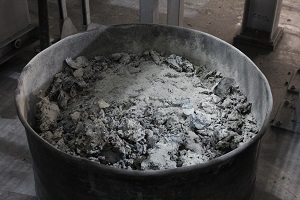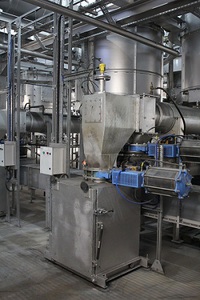

|
Edward Lowton
Editor |


|
| Home> | Plant, Process & Control | >Sensors and instrumentation | >Narrow success for level sensor |
Narrow success for level sensor
29 July 2015
A Vegapuls 69 bulk solids level sensor has been installed at a UK Waste processing facility. Although it has a range of 120m, in this application it is working over a short range – just over 2m – down a very tall nozzle, through a valve and into a confined vessel.

The application is in a high temperature ash outlet from a gasification process where, via a screw conveyor, the hot waste, at around 400°C and under a vacuum, is deposited into a metal barrel container inside sealed cabinet. The barrel level needs to be monitored for changeover; when this is required, the process vacuum is protected by a valve, which closes while the cabinet door is open. This valve is also the portal that the level measurement must be made through and the sensor has to be contactless to measure through it.
Weighing was not an option, as the ash density varies too much, and the high temperatures would cause issues for some other technologies considered. Other measurement challenges include; very high levels of dust and fumes, vacuum, changing particle size and density, no ‘air purging or cooling’ allowed due to the combustion method, as well as the falling waste stream as it drops through the same valve into the barrel.
The original radar level sensors used have worked well with no signal loss, but ash build up and sublimation of vapours, in the narrow confines of the mounting tube and around the valve aperture, have caused periodic problems. This was because the radar sensors, although carefully installed and set up with ‘false signal suppression’, did not have a narrow enough beam angle to avoid the build up, which was causing intermittent high/full barrel levels. Cleaning the internal structures cured these issues, but it was not an easy task, was time consuming and it interrupted the process.
The Vegapuls 69 radar has much narrower focussing (3.5°). The device therefore has no interfering echoes from the nozzle or the 150mm diameter slide valve, which is about 0.8m away from the sensor. The set up was quick and simple, virtually no ‘false signal suppression’ required and it is able to measure directly right down into the barrel, with no loss of signal from the prevailing process conditions.
This increased reliability means that the process is now more productive and change-overs are only called for when needed. Because the measurements are more accurate and the high levels can be more confidently anticipated, the operators can coordinate more efficient change over sequences, saving time and increasing safety. While this new radar has shown excellent near range performance – remember it has a range of up to 120m, enough for the largest of silos, and it also has a fast responsive output, which means it can be used on conveyors and object monitoring applications too.


















